Crystallographic and Thermal Studies of the Polymorphs of Tetraoxa[4]arene with Meta-Phenylene Linkers
Abstract
:1. Introduction
2. Materials and Methods
2.1. General
2.2. Synthesis and Crystallization
2.3. Crystal Structure Determination
3. Results and Discussion
3.1. Preparations of Derivatives 2 and 3
3.2. Crystal Structure and Intermolecular Interactions of 2-Ia
3.3. Crystal Structure and Intermolecular Interactions of 2-II
3.4. Thermal and Comparison Studies of Crystal Structures of 2-I
3.5. Hirshfeld Surface Analysis of the Structures
3.6. Crystal Structure and Intermolecular Interactions of 3 Crystals
4. Conclusions
Author Contributions
Funding
Data Availability Statement
Conflicts of Interest
Appendix A
References
- Gutsche, C.D. Calixarenes. Acc. Chem. Res. 1983, 16, 161–170. [Google Scholar] [CrossRef]
- Ikeda, A.; Shinakai, S. Novel cavity design using calix[n]arene skeletons: Toward molecular recognition and metal binding. Chem. Rev. 1997, 97, 1713–1734. [Google Scholar] [CrossRef] [PubMed]
- Bernard, V.; Isabelle, L. Design principles of fluorescent molecular sensors for cation recognition. Coord. Chem. Rev. 2000, 205, 3–40. [Google Scholar] [CrossRef]
- Dalgarno, S.J.; Thallapally, P.K.; Barbour, L.J.; Atwood, J.L. Engineering void space in organic van der Waals crystals: Calixarenes lead the way. Chem. Soc. Rev. 2007, 36, 236–245. [Google Scholar] [CrossRef] [PubMed]
- Ogoshi, T.; Yamagishi, T.; Nakamoto, Y. Pillar-shaped macrocyclic hosts pillar[n]arenes: New key players for supramolecular chemistry. Chem. Rev. 2016, 116, 7937–8002. [Google Scholar] [CrossRef] [PubMed]
- Isabelle, L.; Bernard, V. Calixarene-based fluorescent molecular sensors for toxic metals. Eur. J. Inorg. Chem. 2009, 24, 3525–3535. [Google Scholar] [CrossRef]
- Zadmard, R.; Akbarzadeha, A.; Jalalia, M.R. Highly functionalized calix[4]arenes via multicomponent reactions: Synthesis and recognition properties. RSC Adv. 2019, 9, 19596–19605. [Google Scholar] [CrossRef]
- Han, X.-N.; Han, Y.; Chen, C.-F. Recent advances in the synthesis and applications of macrocyclic arenes. Chem. Soc. Rev. 2023, 52, 3265–3298. [Google Scholar] [CrossRef] [PubMed]
- Yang, L.-P.; Wang, X.; Yao, H.; Jiang, W. Naphthotubes: Macrocyclic hosts with a biomimetic cavity feature. Acc. Chem. Res. 2020, 53, 198–208. [Google Scholar] [CrossRef]
- Tian, H.-W.; Liu, Y.-C.; Guo, D.-S. Assembling features of calixarene-based amphiphiles and supra-amphiphiles. Mater. Chem. Front. 2020, 4, 46–98. [Google Scholar] [CrossRef]
- Lumetta, G.J.; Rogers, R.D.; Gopalan, A.S. Calixarenes for Separations; ACS: Washington, WA, USA, 2000; pp. 107–312. [Google Scholar]
- Jie, K.; Zhou, Y.; Li, E.; Huang, F. Nonporous adaptive crystals of pillararenes. Acc. Chem. Res. 2018, 51, 2064–2072. [Google Scholar] [CrossRef]
- Weissbuch, I.; Addadi, L.; Lahav, M.; Leiserowit, L. Molecular recognition at crystal interfaces. Science 1991, 253, 637–645. [Google Scholar] [CrossRef] [PubMed]
- Gutsche, C.D.; Kye, C.-N. Calixarenes. 22. Synthesis, properties, and metal complexation of aminocalixarenes. J. Am. Chem. Soc. 1988, 110, 6153–6162. [Google Scholar] [CrossRef] [PubMed]
- Ohto, K.; Yano, M.; Inoue, K.; Nagasaki, T.; Goto, M.; Nakashio, F.; Shinkai, S. Effect of coexisting alkaline metal ions on the extraction selectivity of lanthanido ions with calixarene carboxylate derivatives. Polyhedron 1997, 16, 1655–1661. [Google Scholar] [CrossRef]
- Danil de Namor, A.F.; Chahine, S.; Kowalska, D.; Costellano, E.E.; Piro, O.E. Selective interaction of lower rim calix[4]arene derivatives and bivalent cations in solution. Crystallographic evidence of the versatile behavior of acetonitrile in lead(II) and cadmium(II) complexes. J. Am. Chem. Soc. 2002, 124, 12824–12836. [Google Scholar] [CrossRef] [PubMed]
- Ahmed, S.A.; Tanaka, M.; Ando, H.; Iwamoto, H.; Kimura, K. Chromened t-butylcalix[4]arenes: Cooperation effect of chromene and calixarene moieties on photochromism and metal-ion binding ability. Tetrahedron 2003, 59, 4135–4142. [Google Scholar] [CrossRef]
- Ogoshi, T.; Kanai, S.; Fujinami, S.; Yamagishi, T.; Nakamoto, Y. para-Bridged symmetrical pillar[5]arenes: Their Lewis acid catalyzed synthesis and host–guest property. J. Am. Chem. Soc. 2008, 130, 5022–5023. [Google Scholar] [CrossRef] [PubMed]
- Sawada, T.; Hongo, T.; Matsuo, N.; Konishi, M.; Kawaguchi, T.; Ihara, H. Hemisphere-shaped calixarenes and their analogs: Synthesis, structure, and chiral recognition ability. Tetrahedron 2011, 67, 4716–4722. [Google Scholar] [CrossRef]
- Aragay, G.; Hernández, D.; Verdejo, B.; Escudero-Adán, E.C.; Martínez, M.; Ballester, P. Quantification of CH-π interactions using calix[4]pyrrole receptors as model systems. Molecules 2015, 20, 16672–16686. [Google Scholar] [CrossRef]
- Romero, J.; Barberá, J.; Blesa, M.-J.; Concellón, A.; Romero, P.; Serrano, J.L.; Marcos, M. Liquid crystal organization of calix[4]arene-appended schiff bases and recognition towards Zn2+. ChemistrySelect 2017, 2, 101–109. [Google Scholar] [CrossRef]
- He, L.; Wang, S.-C.; Lin, L.-T.; Cai, J.-Y.; Li, L.; Tu, T.-H.; Chan, Y.-T. Multicomponent metallo-supramolecular nanocapsules assembled from calix[4]resorcinarene-based terpyridine ligands. J. Am. Chem. Soc. 2020, 142, 7134–7144. [Google Scholar] [CrossRef]
- Matsumoto, T.; Sasaki, T.; Tonosaki, A.; Hattori, T. Mechanistic consideration for the selective inclusion of disubstituted benzene isomers with p-tert-butylcalix[4]arene crystals. Cryst. Growth Des. 2021, 21, 5006–5016. [Google Scholar] [CrossRef]
- Li, M.; Shao, L.; Liu, Z.; Liu, R.; Stoikov, I.I.; Khashab, N.M.; Hua, B.; Huang, F. Cis−trans and length-selective molecular discrimination of halogenated organic compounds by a crystalline hybrid macrocyclic arene. ACS Appl. Mater. Interfaces 2024, 16, 6614–6622. [Google Scholar] [CrossRef] [PubMed]
- Ikumura, Y.; Habuka, Y.; Sakai, S.; Shinohara, T.; Yuge, H.; Rzeznicka, I.I.; Hori, A. Enhanced and heteromolecular guest encapsulation in nonporous crystals of a perfluorinated triketonato dinuclear copper complex. Chem. Eur. J. 2020, 26, 5051–5060. [Google Scholar] [CrossRef]
- Habuka, Y.; Usui, H.; Okawa, M.; Shinohara, T.; Yuge, H.; Mao, Y.; Gong, J.; Richards, G.J.; Hori, A. Selective recognition and reversible encapsulation of tetrameric alcohol clusters via hydrogen bonds using a perfluorinated dinuclear nickel(II) complex. CrystEngComm 2024, 26, 3014–3020. [Google Scholar] [CrossRef]
- Smith, G.W. Crystal Structure of a nitrogen isostere of pentacyclo-octacosadodecaene. Nature 1963, 198, 879. [Google Scholar] [CrossRef]
- Maesa, W.; Dehaen, W. Oxacalix[n](het)arenes. Chem. Soc. Rev. 2008, 37, 2393–2402. [Google Scholar] [CrossRef]
- Kumagai, H.; Hasegawa, M.; Miyanari, S.; Sugawa, Y.; Sato, Y.; Hori, T.; Ueda, S.; Kamiyama, H.; Miyano, S. Facile synthesis of p-tert-butylthiacalix[4]arene by the reaction of p-tert-butylphenol with elemental sulfur in the presence of a base. Tetrahedron Lett. 1997, 38, 3971–3972. [Google Scholar] [CrossRef]
- Katz, J.L.; Feldman, M.B.; Conry, R.R. Synthesis of functionalized oxacalix[4]arenes. Org. Lett. 2005, 7, 91–94. [Google Scholar] [CrossRef] [PubMed]
- Wang, M.-X. Nitrogen and oxygen bridged calixaromatics: Synthesis, structure, functionalization, and molecular recognition. Acc. Chem. Res. 2012, 45, 182–195. [Google Scholar] [CrossRef] [PubMed]
- Kumar, R.; Lee, Y.O.; Bhalla, V.; Kumar, M.; Kim, J.S. Recent developments of thiacalixarene based molecular motifs. Chem. Soc. Rev. 2014, 43, 4824–4870. [Google Scholar] [CrossRef] [PubMed]
- Canard, G.; Edzang, J.A.; Chen, Z.; Chessé, M.; Elhabiri, M.; Giorgi, M.; Siri, O. 1,3-Alternate tetraamido-azacalix[4]arenes as selective anion receptors. Chem. Eur. J. 2016, 22, 5756–5766. [Google Scholar] [CrossRef]
- Takemura, H. Synthesis of azacalixarenes and development of their properties. Molecules 2021, 26, 4885. [Google Scholar] [CrossRef] [PubMed]
- Kleyn, A.; Jacobs, T.; Barbour, L.J. Solid-state structural studies of oxacalix[2]arene[2]naphthalene as a molecular tweezer. CrystEngComm 2011, 13, 3175–3180. [Google Scholar] [CrossRef]
- Petersen, R.J.; Rozeboom, B.J.; Oburn, S.M.; Blythe, N.J.; Rathje, T.L.; Luna, J.A.; Kibby, S.K.; O'Brien, E.A.; Rohr, K.G.; Carpenter, J.R.; et al. Cambiarenes: Single-step synthesis and selective zwitterion binding of a clip-shaped macrocycle with a redox-active Core. Chem. Eur. J. 2019, 26, 1928–1930. [Google Scholar] [CrossRef] [PubMed]
- Wan, K.; Gao, S.-C.; Fang, X.; Xu, M.-Y.; Yang, Y.; Xue, M. Oxacalix[4]arene-bridged pillar[5]arene dimers: Syntheses, planar chirality and construction of chiral rotaxanes. Chem. Commun. 2020, 56, 10155–10158. [Google Scholar] [CrossRef] [PubMed]
- Yao, C.; Zhang, S.; Wang, L.; Tao, X. Recent advances in polymorph discovery methods of organic crystals. Cryst. Growth Des. 2023, 23, 637–654. [Google Scholar] [CrossRef]
- Peterson, A.; Kaabel, S.; Kahn, I.; Pehk, T.; Aav, R.; Adamson, J. Unsubstituted Oxacalix[n]arenes (n=4 and 8): A conformational study in solution and solid state and interaction studies with aromatic guests. ChemistrySelect 2018, 3, 9091–9095. [Google Scholar] [CrossRef]
- Hori, A.; Betsugi, E.; Ikumura, Y.; Yoza, K. Polymorphic crystals of oxacalix[4]arene with 1,3-alternate conformations of S4 and C2 symmetry. Acta Cryst. 2019, C75, 265–270. [Google Scholar] [CrossRef]
- Zhou, Q.; Su, L.; Jiang, T.; Zhang, B.; Chen, R.; Jiang, H.; Ye, Y.; Zhu, M.; Han, D.; Shen, J.; et al. Copper/iron-catalyzed Ullmann coupling of diiodo- and dibromoarenes and diphenols for the synthesis of aryl ether macrocycles. Tetrahedron 2014, 70, 1125–1132. [Google Scholar] [CrossRef]
- Sheldrick, G.M. SHELXT–Integrated space-group and crystal-structure determination. Acta Cryst. 2015, A71, 3–8. [Google Scholar] [CrossRef]
- Sheldrick, G.M. Crystal structure refinement with SHELXL. Acta Cryst. 2015, C71, 3–8. [Google Scholar] [CrossRef]
- Thakuria, R.; Nath, N.K.; Saha, B.K. The nature and applications of π–π interactions: A Perspective. Cryst. Growth Des. 2019, 19, 523–528. [Google Scholar] [CrossRef]
- Nishio, M.; Hirota, M. CH/π interaction: Implications in organic chemistry. Tetrahedron 1989, 45, 7201–7245. [Google Scholar] [CrossRef]
- Sun, J.; Tian, Z.-Y.; Liu, J.; Wan, C.; Dai, C.; Liu, Z.; Xing, Y.; Wu, Y.; Hou, Z.; Han, W.; et al. Intramolecular CH⋯π attraction mediated conformational polymorphism of constrained helical peptides. Chem. Sci. 2024, 15, 14264–14272. [Google Scholar] [CrossRef]
- Spek, A.L. Single-crystal structure validation with the program PLATON. J. Appl. Cryst. 2003, 36, 7–13. [Google Scholar] [CrossRef]
- Spackman, M.A.; Jayatilaka, D. Hirshfeld surface analysis. CrystEngComm 2009, 11, 19–32. [Google Scholar] [CrossRef]
- Hirshfeld, F.L. Bonded-atom fragments for describing molecular charge densities. Theor. Chim. Acta 1977, 44, 129–138. [Google Scholar] [CrossRef]
- Turner, M.J.; McKinnon, J.J.; Wolff, S.K.; Grimwood, D.J.; Spackman, P.R.; Jayatilaka, D.; Spackman, M.A. CrystalExplorer17.5; University of Western Australia: Perth, Australia, 2017; Available online: http://hirshfeldsuface.net (accessed on 10 November 2024).
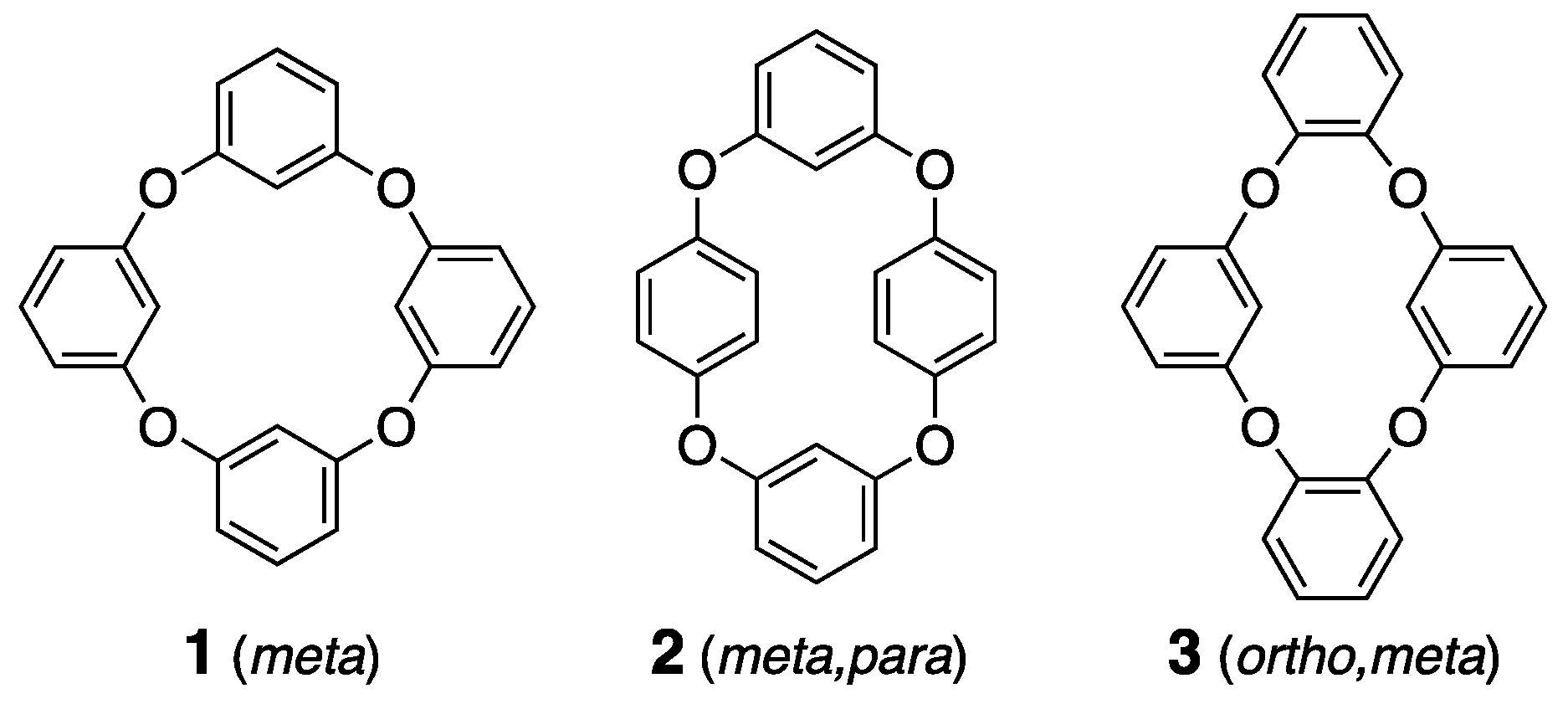



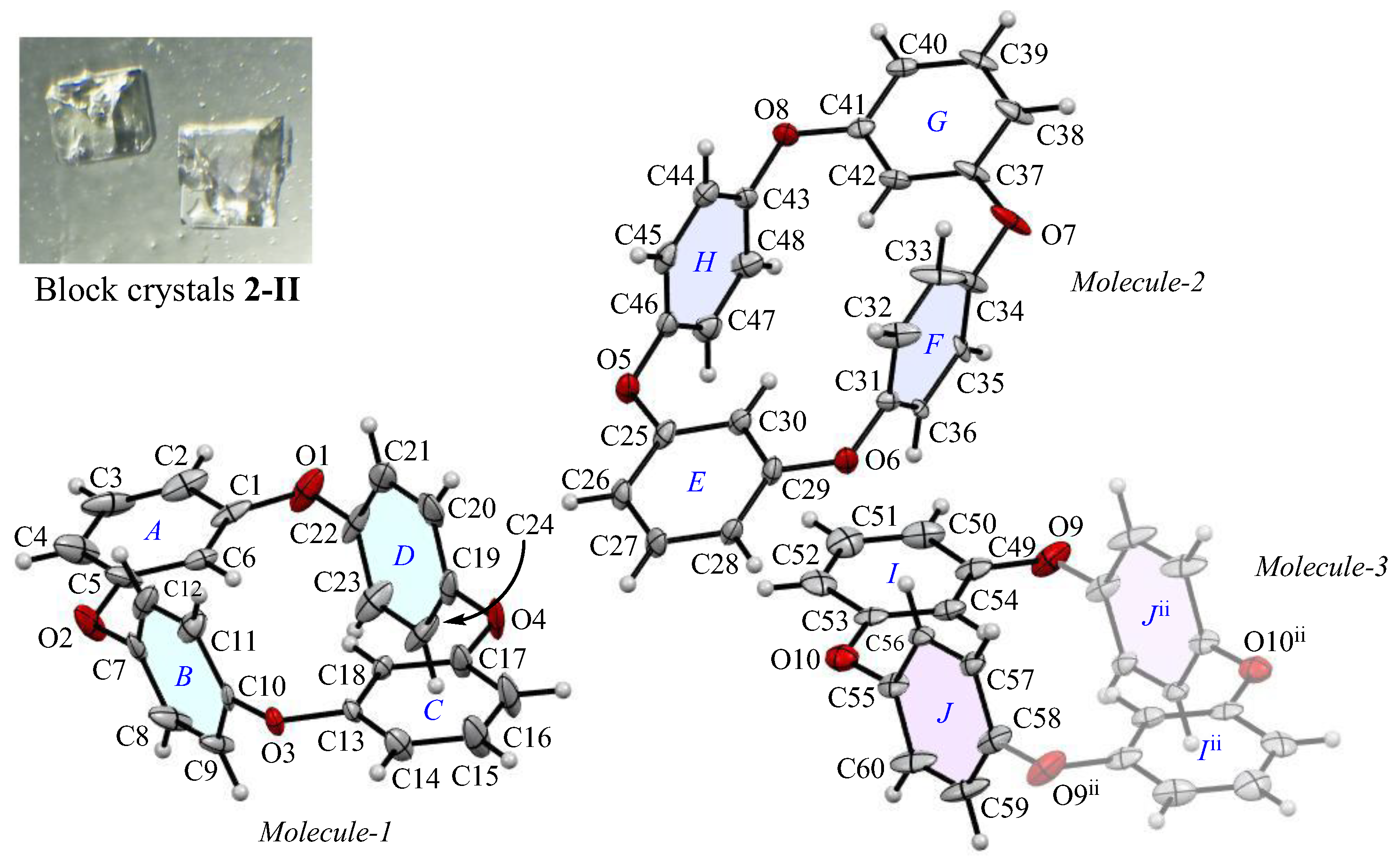
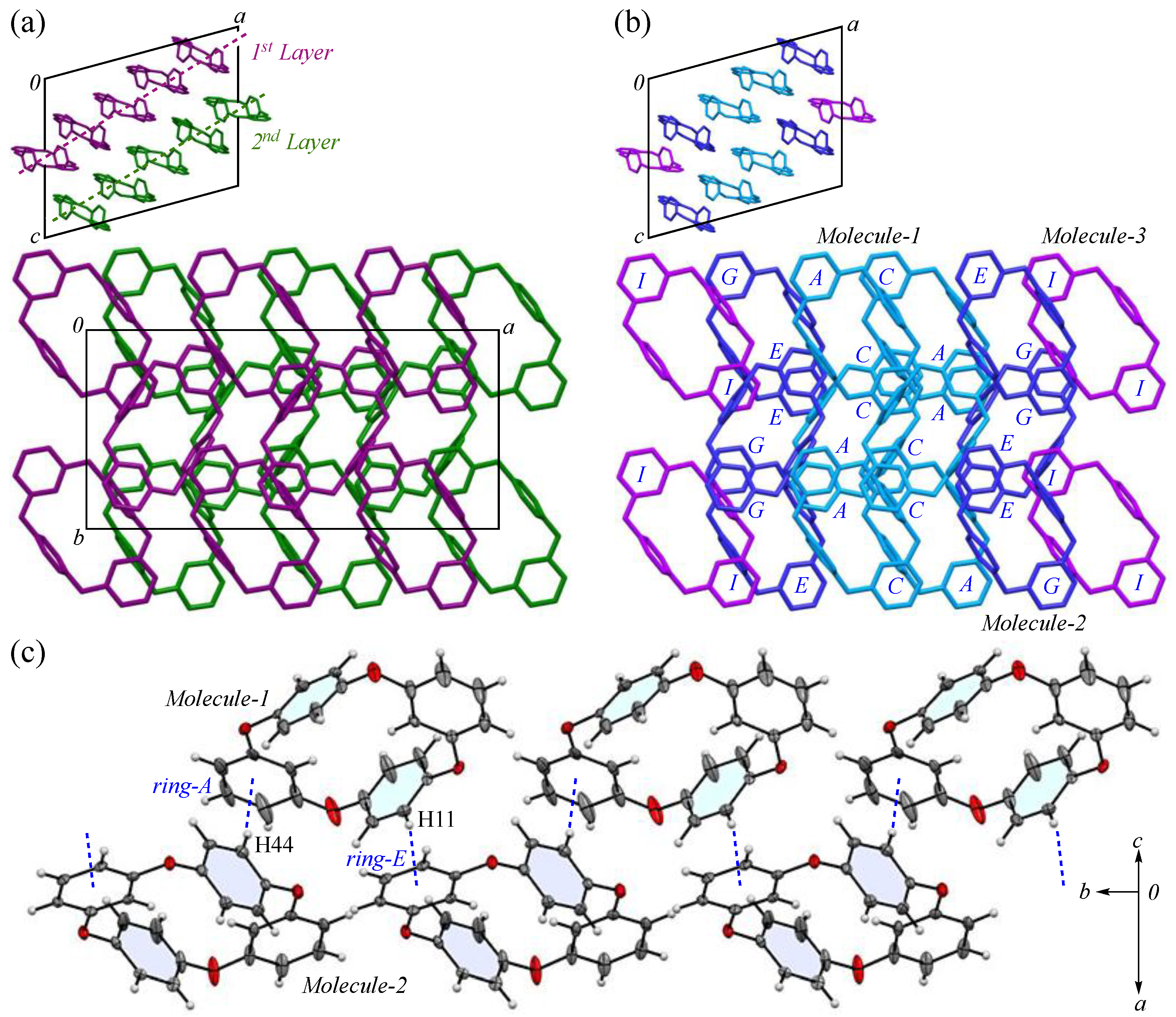
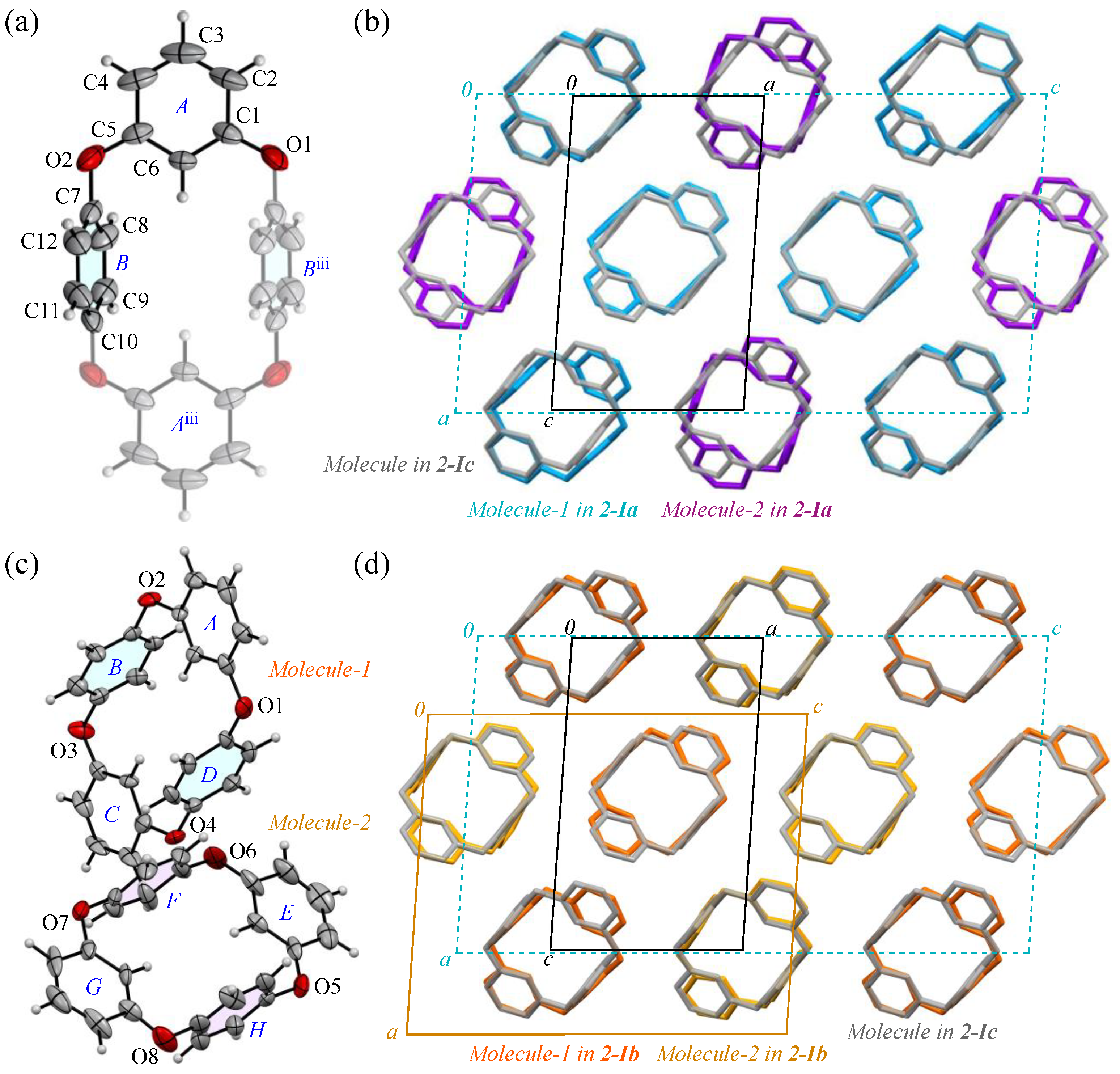

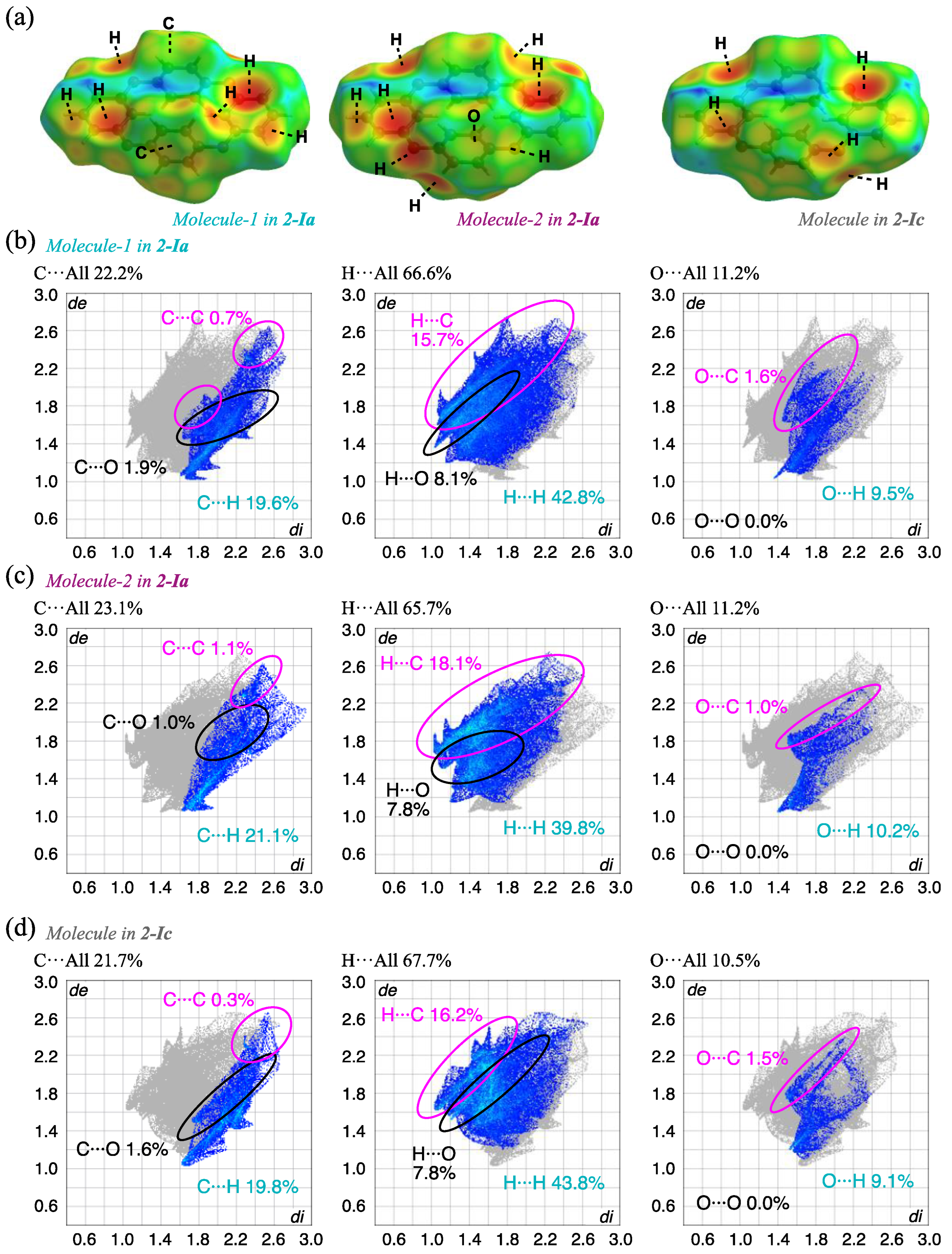
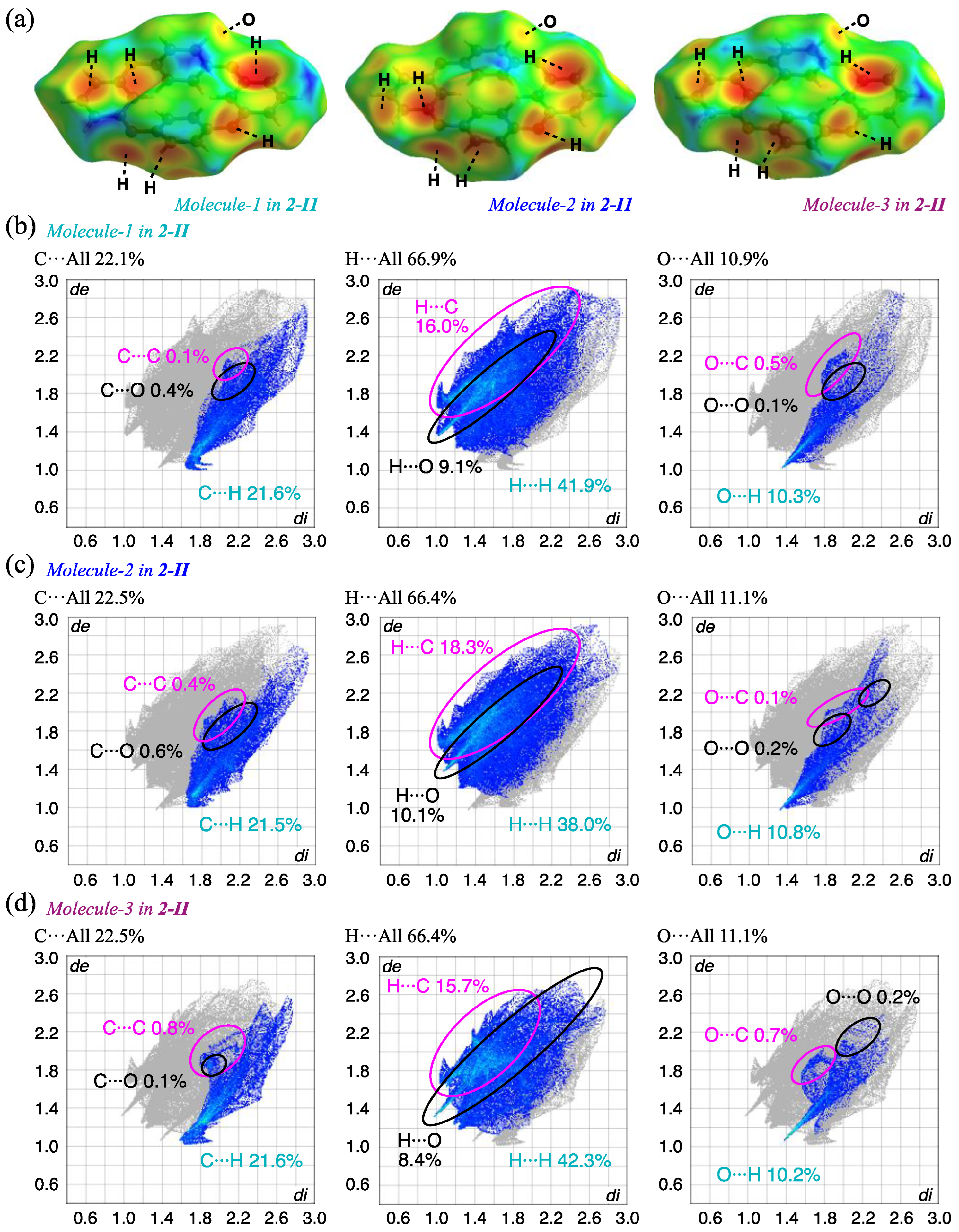

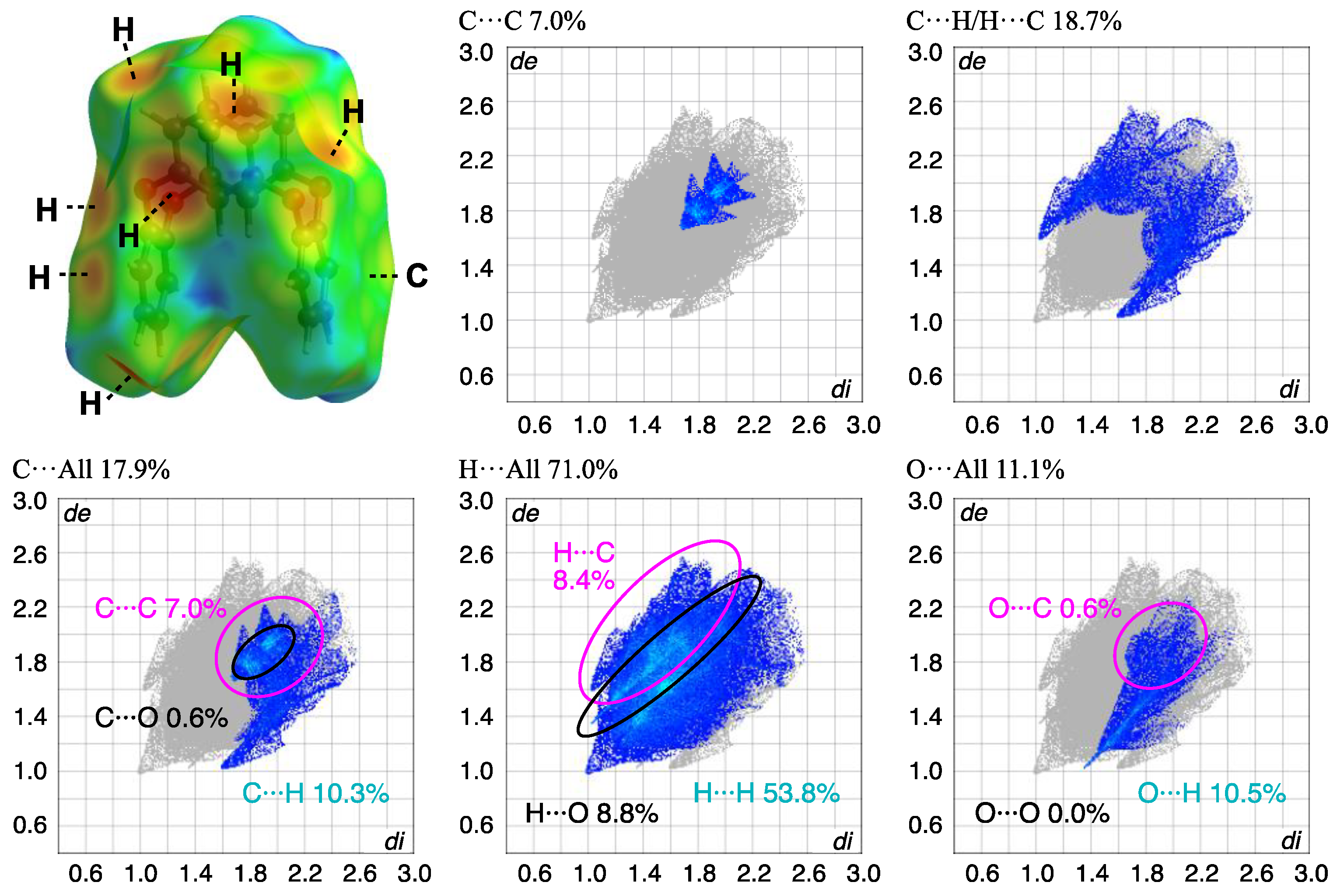
| 2-Ia | 2-Ib | 2-Ic | 2-II | 3 | |
|---|---|---|---|---|---|
| Description | Prismatic | Prismatic | Prismatic | Block | Prismatic |
| T [K] | 100 | 200 | 302 | 100 | 100 |
| Crystal system | Monoclinic | Monoclinic | Monoclinic | Monoclinic | Monoclinic |
| Space group | P21/n | P21 | P21/n | P21/c | P21/n |
| a [Å] | 15.092(10) | 14.967(4) | 9.0983(6) | 23.419(3) | 13.336(3) |
| b [Å] | 6.823(4) | 6.9044(16) | 6.9470(4) | 10.8722(14) | 8.836(2) |
| c [Å] | 26.85(2) | 18.127(4) | 14.9094(9) | 18.997(3) | 16.028(4) |
| β [°] | 92.56(3) | 93.917(8) | 93.881(2) | 104.431(4) | 106.370(9) |
| V [Å3] | 2762(3) | 1868.9(8) | 940.20(10) | 4684.2(11) | 1812.1(8) |
| Z | 6 | 4 | 2 | 10 | 4 |
| Dc [Mg m−3] | 1.329 | 1.309 | 1.301 | 1.306 | 1.350 |
| μ [mm−1] | 0.090 | 0.089 | 0.088 | 0.089 | 0.092 |
| F(000) | 1152 | 768 | 384 | 1920 | 768 |
| Rint | 0.0560 | 0.0985 | 0.0511 | 0.0691 | 0.0936 |
| GOF | 1.055 | 1.092 | 1.002 | 1.005 | 0.954 |
| R [(I) > 2σ (I)] | 0.0666 | 0.0927 | 0.0497 | 0.0902 | 0.0514 |
| wR (Fo2) | 0.2171 | 0.2817 | 0.1129 | 0.2136 | 0.1536 |
| CCDC No. | 2396584 | 2396585 | 2396586 | 2396587 | 2396588 |
| T [K] | a [Å] | b [Å] | c [Å] | β [°] | V [Å3] |
|---|---|---|---|---|---|
| 100 | 15.078(8) | 6.852(4) | 26.954(19) | 92.85(2) | 2781(5) |
| 150 | 15.069(11) | 6.861(5) | 27.06(2) | 93.04(3) | 2794(6) |
| 200 | 14.967(4) | 6.9044(16) | 18.127(4) | 93.917(8) | 1868.9(8) |
| 250 | 9.102(8) | 6.927(5) | 14.878(11) | 93.93(3) | 936(2) |
| 300 | 9.100(8) | 6.938(6) | 14.886(12) | 93.86(3) | 938(2) |
| 2-Ia | 2-Ib | 2-Ic | 2-II | 3 | |||||
|---|---|---|---|---|---|---|---|---|---|
| Molecule No. | 1 | 2 | 1 | 2 | 1 | 2 | 3 | ||
| C···C | 0.7 | 1.1 | 0.5 | 0.3 | 0.3 | 0.1 | 0.4 | 0.8 | 7.0 |
| H···H | 42.8 | 39.8 | 43.8 | 42.8 | 43.8 | 41.9 | 38.0 | 42.3 | 53.8 |
| O···O | 0.0 | 0.0 | 0.0 | 0.0 | 0.0 | 0.1 | 0.2 | 0.2 | 0.0 |
| C···H/H···C | 35.3 | 39.2 | 34.9 | 37.2 | 36.0 | 37.5 | 39.8 | 37.3 | 18.7 |
| C···O/O···C | 3.5 | 2.0 | 4.1 | 2.4 | 3.1 | 0.9 | 0.7 | 0.8 | 1.2 |
| H···O/O···H | 17.6 | 18.0 | 16.7 | 17.3 | 16.8 | 19.4 | 20.9 | 18.6 | 19.4 |
Disclaimer/Publisher’s Note: The statements, opinions and data contained in all publications are solely those of the individual author(s) and contributor(s) and not of MDPI and/or the editor(s). MDPI and/or the editor(s) disclaim responsibility for any injury to people or property resulting from any ideas, methods, instructions or products referred to in the content. |
© 2024 by the authors. Licensee MDPI, Basel, Switzerland. This article is an open access article distributed under the terms and conditions of the Creative Commons Attribution (CC BY) license (https://creativecommons.org/licenses/by/4.0/).
Share and Cite
Ishida, Y.; Kawasaki, T.; Hori, A. Crystallographic and Thermal Studies of the Polymorphs of Tetraoxa[4]arene with Meta-Phenylene Linkers. Crystals 2024, 14, 1032. https://doi.org/10.3390/cryst14121032
Ishida Y, Kawasaki T, Hori A. Crystallographic and Thermal Studies of the Polymorphs of Tetraoxa[4]arene with Meta-Phenylene Linkers. Crystals. 2024; 14(12):1032. https://doi.org/10.3390/cryst14121032
Chicago/Turabian StyleIshida, Yuki, Tadashi Kawasaki, and Akiko Hori. 2024. "Crystallographic and Thermal Studies of the Polymorphs of Tetraoxa[4]arene with Meta-Phenylene Linkers" Crystals 14, no. 12: 1032. https://doi.org/10.3390/cryst14121032
APA StyleIshida, Y., Kawasaki, T., & Hori, A. (2024). Crystallographic and Thermal Studies of the Polymorphs of Tetraoxa[4]arene with Meta-Phenylene Linkers. Crystals, 14(12), 1032. https://doi.org/10.3390/cryst14121032







